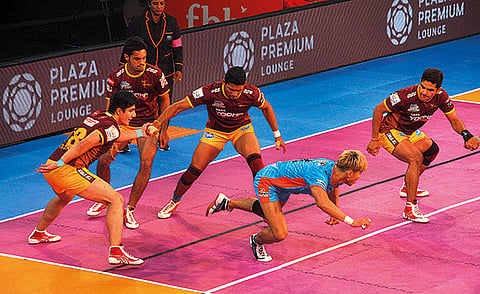New playing field for investment
From leagues and sponsorships to the relatively nascent tourism and retail sectors, India’s sports business is booming

Star Sports, India invested Rs163.4 billion (Dh8.72 billion) to acquire the Indian Premier League telecast rights for five years last November. While many at the time expressed shock and awe, Star has already raked in Rs18.5 billion from the sale of advertisement slots in the first year itself, published data suggests. Add the money from syndication to global broadcasters across the cricket playing world and the sum invested seems a logical and just proposition.
The IPL isn’t an aberration. Kabaddi, an Indian domestic sport for long, has a league — 500 million people watched its first iteration in 2014. The Indian soccer league had a viewership of 400 million. And more than 50,000 Indians are expected to travel to the UK for the Cricket World Cup in June-July 2019.
Clearly the Indian sports scenario is undergoing a change and one that is nothing short of a revolution. “The IPL is the first and only real domestic tournament that people on such a large scale really care about,” says Uday Shankar, CEO and Chairman of Star India and President of 21st Century Fox Asia.
“It is now a massive platform for discovery of home-grown talent. All the fans do their own talent-spotting rather than just follow the players wearing national colours.
“Due to its format, timing, regulations and localisation, IPL and to an extent the other leagues have also brought in large audiences that would otherwise not come to sport.
“Above all India never loses in IPL. So some part or the other of India is always excited.”
Changing scenario
Significant growth in sports tourism and retail sectors are other markers of this transformation. “With technology, sports is the new aspiration for the Indian middle and upper-middle class,” says Raghav Gupta, Head of Fanatic Sports, one of India’s leading sports tourism and experiences company. “While you don’t want to stop watching the action on television, you now want to be a part of it and be there.
“Sports is the new bucket list for the discerning Indian traveller. We have a couple of thousand tickets for the India-Pakistan World Cup match in Manchester in June 2019. With still a year to go we have received more than 10,000 enquiries.
“The demand is unreal. We have now gone a step further and are creating itineraries for the Indian sports fan, which weren’t conceivable a year earlier. For example, you can watch the French Open finals and the first India game of the World Cup in 2019 on consecutive days and follow it up with a concert in London. People are loving it.”
Sports retail, with a relatively insignificant share globally for a long time, has also seen phenomenal growth in the past two years. Be it the new French jersey with two stars in the aftermath of the World Cup win or the new Cristiano Ronaldo jersey in his Juventus avatar, the customer spend on sports retail has grown manifold.
Adidas, for example, has put in significant money in promoting its sports business in India. Collaboration with sports academies are commonplace and the Yonex store in the Sai Gopichand National Badminton Academy in Hyderabad already does reasonable business.
With Star putting in big money into cricket broadcast and companies such as Fanatic turning over a new leaf in its valuations, sports is the new go-to industry in India. Unlike in the West where we see valuations for established sports leagues falling, India is a nascent market where things are only looking up, says an industry insider.
“Television has benefited us immensely,” adds cricketer Jhulan Goswami, whose biopic has just recently been announced. “We hope there is a women’s IPL soon enough, for that will give Indian women’s cricket a massive fillip.”
Performances too make a difference. With P.V. Sindhu, Srikanth Kidambi, Saina Nehwal, Prannoy Kumar and others in the top 20 of world badminton and with Gopichand a household name, it is no surprise that a badminton league has takers and sponsors. Between Star and Sony there are 23 round-the-clock dedicated sports channels that beam live international and domestic sport to Indian households.
As a result every league, be it wrestling, boxing, kabaddi, volleyball or football, finds a home. And with women stars such as Mithali Raj, Goswami, Sindhu and Nehwal making news, women’s sport leagues have also started cropping up.
Interestingly, the growth of sports leagues runs parallel to the transformation in the Indian sports media market and the synergy adds to the robustness of the sector.
With the government launching initiatives such as Khelo India, yet again backed by sports broadcasts, this is a trend that will only gather momentum in the coming years. For India being a multi-sports nation is no longer a pipe dream.
Sign up for the Daily Briefing
Get the latest news and updates straight to your inbox



